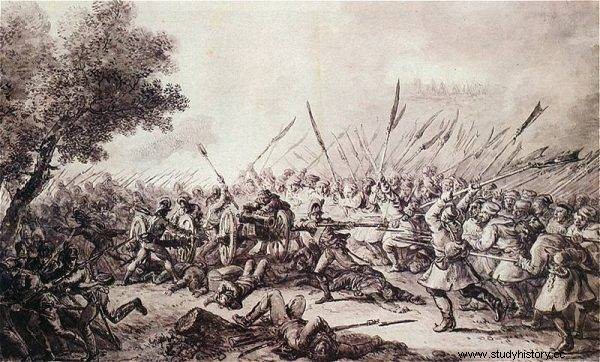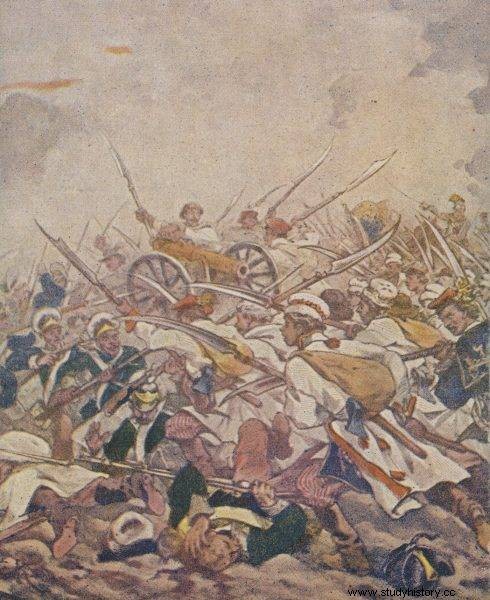The lost war with Russia in 1792 and the second partition of Poland shortly after plunged the Commonwealth into chaos. The outbreak of the uprising in defense of independence was only a matter of time. Its beginning turned out to be triumphant:the victory at Racławice filled Poles with hope that the collapse of their country could still be stopped.
The situation at the end of March 1794, at the beginning of the national uprising, was complicated and put the commander Tadeusz Kościuszko in a difficult position. First of all, he was suffering from a lack of people. Fortunately, soon after he swore to defend Polish borders on March 24, 1794, reinforcements began to reach him.
As a result, the army of the insurgents within a few days grew to over six thousand people, including over four thousand regular soldiers. It also had 12 cannons at its disposal. Kosciuszko intended to concentrate these forces in the vicinity of Krakow for the time being. He divided them into two divisions. The first was commanded by General Józef Zajączek, and the second was given to Antoni Madaliński, who was promoted to the rank of major general.
The first skirmish between Polish troops and Russian troops took place on April 4, 1794 in the morning near Imbramowice. There the front guard of Kościuszko clashed with Major Adrian Denisov's Don Cossacks, who were the outpost of Major General Alexander Tormasov's corps. The latter was sent by the commander-in-chief of the Russian forces, General Fyodor Denisov, to attack the insurgent group from the north. He had three thousand soldiers under his command. It also had an artillery park in the amount of 12 cannons.

Kosciuszko's opponent near Racławice was general Aleksander Tormasow.
Denisov himself wanted to attack from the south at the same time, to take the Polish army into clamps and nip the uprising in the bud. While Tormasow chose the way through Rzędowice and Przesławice, the commander-in-chief headed for Klimontów and Proszowice. His ward was slightly smaller. It consisted of about two and a half thousand soldiers, including five infantry battalions, the same number of cavalry squadrons and six Cossack sotnias. He was dragging six cannons with him.
Waiting game
Meanwhile, Kościuszko, sensing that the main Russian forces were behind the Cossack regiment, decided not to waste time on skirmishes and avoid the enemy. He headed for the road from Słomniki to Działoszyce. However, Tormasov did everything to block his path and force him to battle. To this end, he planted the Kościejowskie Hills, which dominated the area. It was a convenient, extremely difficult position to break through.
When the commander found out about the deployment of enemy forces, he decided that he must try to force him to relocate. He retreated to the village of Dziemierzyce, to the opposite hills, and there he began to prepare his troops for battle. He arranged the infantry in the center, and at the rear, behind the hill - so that they would be invisible to the enemy - concentrated Ślaski's scythe. On the left wing he set up the forces of general Zajączek, and on the right wing - troops led by Madaliński. There are two batteries at the junction of the center and each flank. Polish troops prepared in this way waited idle for the enemy's move.
The Russian general, in turn, was still waiting for reinforcements. He counted on the support of Denisov's corps. Unfortunately, the commander-in-chief delayed the departure. He only left an hour after his subordinate's corps disappeared ... and thus contributed to his defeat. For Tormasov grew more and more impatient. In his mind's eye, he saw him beating Poles, triumphing over Kościuszko and collecting laurels of victory.
Let's attack!
The battle finally began around 3pm. At the signal given by Tormasov, the Russian troops began descending the hills, heading towards the enemy. For the site of the battle, the Russian commander chose the fields between Janowniczki and Dziemierzyce, on the left side of the road from Racławice to Dziemierzyce. It was there that he gave the order to take the battle stance. At the same time, he sent part of his forces with one or two cannons, under the command of Lieutenant Colonel Pustovalov, to perform a flanking maneuver. These troops passed through the forests and emerged unexpectedly from the north, attacking the left wing of the Poles.
Tormasov started the attack with a solid artillery fire. The general used the resulting veil, throwing the Akhtra hussars and horse jegrs of Jelizavetgrad, supported on the sides by Don Cossacks, to the charge.
Unfortunately, the 2nd brigade of the Lesser Poland national cavalry led by Manget did not withstand the attack of the Russian cavalry. With the exception of one squadron, its members disintegrated and began to flee the battlefield. Some of them stopped only in Krakow, spreading in horror false information about the total defeat of the insurgent army, and even - about Kościuszko's death at the hands of the Russians!
However, only a few units were in a panic. The rest of the Polish army remained in position. Especially the artillerymen, who methodically offended the attackers, kept their cool blood. The commander himself remained calm, also when he was informed about the arrival of Pustovalov's column. When she suddenly attacked with all her might from the north, attacking the left wing, he immediately deployed Madaliński's brigade there. The Poles held back the enemy forces with all their strength, but it turned out that the Russian infantry successfully broke their charges.

The Battle of Racławice in the drawing by Aleksander Orłowski.
Tormasov was almost sure of victory. He decided to strengthen Pustovalov's troops, hoping that they would cause panic among the insurgents. For this, he sent the lieutenant colonel his cavalry under the command of Muromtsov. Moreover, striving to maintain close contact with the right wing, where - as he believed - the battle was to be resolved, he sent Major Temirazjew there with part of the 2nd battalion of Yegers. The task of the Russians was to control the edge of the forest on the road from Janowiczki to Dziemierzyce. They forcefully attacked the shooters from the 2nd regiment of Polish infantry, displacing them from their positions.
"God and Fatherland"
The movements of the Russian general did not go unnoticed, however, by Kosciuszko, who noticed that the enemy had weakened his forces in the center too much and decided to take advantage of this mistake. He strengthened Madaliński with a part of his infantry, so that he could hold positions, but he decided to direct the main attack towards the center, at the forces directly subordinate to Tormasov. So he gathered the infantry in the strength of four companies and supported them with the kosyniers who had been standing in the reserve so far. They were to deal the decisive blow to the enemy.
The attack of the scythe was preceded by a hurricane shelling by Polish artillery. The Russian positions were under a hail of bullets. Kościuszko used this moment to go personally to the units waiting in reserve. He addressed the peasants in short, simple words. He waved his hand at the Russian cannons, uttering a simple slogan:"God and Fatherland!". And the scythe, touched by his words, set off on the enemy with deep faith and enthusiasm.

Chłopi mężnie walczyli pod Racławice / Image by Wojciech Kossak
Knowing how important this attack would be for the fate of the battle, the Polish commander decided to additionally protect himself. On the sides of the peasant detachment he placed two companies of the 6th infantry regiment. The soldiers were supposed to support the attack with their weapons, bayonets, but also ... to counter the possible desertion of the peasants!
The chief's fears turned out to be unfounded. The peasants wanted revenge against the Russians. They pounced on the enemy with great bravery. Shouting "Death or Victory!", They caught up with the enemy's batteries and, capturing the cannons one by one, began the slaughter. They did not know military customs, so the word pardon meant nothing to them.
After the gunners and servants of the gunners were slaughtered, the scythe-soldiers pounced on. Russian battle-hardened infantrymen were surprised by the force of this attack. Panic seized them and they began to back away. Even tsarist officers, who threatened deserters with headshots, were unable to stop them. The defeat was complete, the more so as the pogrom of the enemy troops in the center was completed by an attack by horse volunteers from Taszycki who attacked the escapees, killed many of them and captured their banner.
Kosciuszko, who was observing the course of events, decided to use the panic in the ranks of the enemy's troops. He supported the left wing with a second throw of scythes. General Zajączek, and ordered major Konstanty Lucke to strike with the first battalion of the 2nd bayonet foot regiment. Soon, although the Russians defended themselves bravely, their resistance was broken.

The Battle of Racławice ended in a complete defeat of the Russians.
Tormasov tried to save the fleeing infantry in panic. He ordered the cavalry under the command of Colonel Muramtsov to break through from the right flank to the center and provide cover for the escaping ones. However, it turned out to be impossible. The unit not only did not reach the area of the most severe fighting, but was encircled by the tightening ring of Poles and surrendered.
Meanwhile, around 6 p.m., the Russian commander-in-chief, General Denisov, finally arrived in the vicinity of the fighting. Already near Wrocimowice, he encountered refugees from the battlefield. None of them was able to give him a rational answer to the question about the strength of the Polish army. Misinformation from panicked Russians, grateful to God and to fate that they had escaped with their lives, suggested that Kościuszko had a big advantage. The general did not dare to go on the offensive, all the more so as it was slowly falling dark, and he withdrew to Casimir the Great.
Victory… and what next?
The victory of the Poles was overwhelming. The Russians lost about a thousand soldiers, with the losses of Poles reaching 500 people. Unfortunately, the triumph was not fully exploited. The warden found himself in a difficult situation, because the soldiers, after the fight, simply… stopped being in line. Regardless of any orders, they left the ranks en masse and looked for loot. As a result, there was no chance to organize a chase after the escaping Russians, which could lead to their complete destruction and contribute to the cleansing of Małopolska of enemy troops.
Although the battle of Racławice did not have much military significance, its political and moral overtone was huge. Thanks to it, the uprising spread to other regions of Poland. It also broke out in Warsaw. The faith in victory began to arise among Poles. They also understood that only the fight against the invaders would help them regain their Homeland.
Find out more:
- Askenazy S., Tadeusz Kościuszko 1746–1817 , E. Wende, Warsaw 1917.
- Łukaszewicz W., Targowica and the Kościuszko Uprising. From studies on the history of Poland in the 18th century , MON Publishing House, Warsaw 1953.
- Kocój H., Polish calculations in the Kościuszko Uprising to help France , "Rocznik Naukowy" WSWF in Krakow, vol. 9 (1970).
- Kowalczyk R., Tormasow Aleksander Piotrowicz , [in:] Famous and unknown officers and generals of the war of 1812 in Russia , Adam Marszałek Publishing House, Toruń 2013.
- Kozłowski w., Kościuszko's mission in Paris in 1793 , Lviv 1899.
- Pachoński J., Bitwa pod Racławicami , Państwowe Wydawnictwo Naukowe, Warsaw - Krakow 1984.
- Szyndler B., Kościuszko Uprising 1794 , Ancher Publishing House, Warsaw 1994.
- Szyndler B., Tadeusz Kościuszko 1764 - 1817 , Bellona, Warsaw 1991.
- Tokarz W., Battle of Racławicami , "Polish soldier", no. 35–36 (1924).
